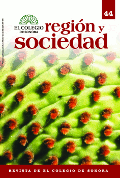 |
 |
 |
 |
 |
 |
 |
 |
 |
 |
 |
 |
Abstract
Recently, Mexico's maquiladora industry has reduced its rate of growth. This study estimates the impact of the United States' industrial activity and China's exports on labor demand in the maquiladoras of the northern border states of Mexico. With data on US industrial activity, Chinese exports, wages and the exchange rate, a time series cointegration model was developed. The results show that exports from China to the us and maquiladora wages have affected labor demand in the maquiladora negatively, while factors such as the average size of the plant, the industrial production of the US, and the exchange rate tend to encourage maquiladora activity.
References
BANXICO. Estadísticas, sistema financiero, mercado cambiario. http://www.banxico.org.mx/PortalesEspecializados/tiposCambio/indicadores.html.
BIE del INEGI. Industria maquiladora de exportación, http://dgcnesyp.inegi.org.mx/cgi–win/bdieintsi.exe/NIVJ15#ARBOL.
Blanchard, Olivier y Danny Quah. 1989. The Dynamic Effect of Aggregate Demand and Supply Disturbances. The American Economic Review (79) 4: 655–673.
Davidson, J. E. H, H. Hendry, D.F. Srba y S.Yeo. 1978. Econometric Modeling of the Aggregate Time–series Relationship between Consumers. The Economic Journal 88: 661–692.
Dickey, D. A., y A. Fuller. 1981. Likelihood Ratio Statistics for Autoregressive Time Series with a Unit Root. Econometrica 49: 1057–1072.
––––––––––. 1979. Distribution of the estimators for Autoregressive Time Series with a Unit Root. Journal of the American Statistical Association 74: 427–431.
Dussel Peters, Enrique. 2007. La relación económica y comercial entre China y México: propuestas para su profundización en el corto, mediano y largo plazos. En Oportunidades en la relación económica y comercial entre China y México, coordinado por ídem., 165–228. http://www.economia.unam.mx/cechimex/QS/LibroOportunidadesyRetos/OportunidadesChina–Mexico2007 (23 de octubre de 2008).
––––––––––. 2005. Implications of China s Recent Economic Performance for Mexico. Briefing Papers, Dialogue on Globalization. Berlin: Friedrich Ebert Stiftung. http://www.nuso.org/upload/fes_pub/China_Mex.pdf (23 de octubre de 2008).
Economic Time Series, http://www.economagic.com.
Engle, E. Robert y C. W J. Granger. 1987. Co–integration and Error Correction Representation, Estimation, and Testing. Econometrica (55) 2: 251–276.
Enders, Walter. 2004. Applied Econometric Times Series. New Jersey: Wiley.
FTD, U.S. Census Bureau. Washington, D.C. 20233. http://www.census.gov/foreign–trade/www/.
Fullerton, Thomas y Patricia Barraza. 2003. Maquiladora Prospects in a Global Business Environment. Texas Business Review octubre: 1–5.
Granger, C.W. J. y P. Newbold. 1974. Spurious Regressions in Econometrics. Journal of Econometrics 4: 111–120.
Gruben, William C. 2001. Was NAFTA behind Mexico's high Maquiladora Growth? Economic and Financial Review third quarter: 11–21.
Hall, Robert, Martin Feldstein, Ben Bernanke, Jeffrey Frankel, Robert Gordon y Victor Zarnowitz. 2001. The Business–cycle Peak, http://www.nber.org /cycles/november2001/recessions.pdf (23 de octubre de 2008).
Hanson, Gordon. 1994. Regional Adjustment to Trade Liberalization, NBER, Working paper, no. 4713. http://www.nber.org/papers/w4713.pdf (23 de octubre de 2008).
Hendry F., David. 1995. Dynamic Econometrics. Oxford: Oxford University Press.
––––––––––. 1985. Econometrics–alchemy or Science. Económica, New Series (47) 188: 387–406.
INEGI–BANXICO–SAT (grupo de trabajo), SE y BIE del INEGI. http://dgcnesyp.inegi.org.mx/cgi–win/bdieintsi.exe/SER115989.
Jhonston, Jack y John Dinardo. 1997. Econometric Methods. Nueva York: McGraw–Hill International Edition.
Johansen, Soren y Katerina Juselius. 1990. Maximum Likelihood Estimation and Inference in Cointegration with Application to the Demand of Money. Oxford Bulletin of Economics and Statistics 52: 169–209.
Juselius, Katerina. 2006. The Cointegrated var Model: Methodology and Applications. Nueva York: Oxford University Press.
Lall, Sanjaya. 1998. Exports of Manufactures by Developing Countries: Emerging Patterns of Trade and Location. Oxford Review of Economic Policy (14) 2: 54–73.
Mejía Reyes, Pablo. 2003. Fluctuaciones cíclicas en la producción maquiladora de México. Frontera Norte (15) 29: 65–86.
Mendoza, Eduardo y Cuauhtémoc Calderón. 2001. Determinantes regionales de la maquiladora de exportación en la frontera norte. Comercio Exterior (49) 3: 196–202.
Mezquita Moreira, Mauricio. 2006. La competencia manufacturera de China con América Latina. Comercio Exterior (56) 11: 1000–1007.
National Bureau of Statistics of China, China Statistical Yearbook. 1996, 2004, 2006. http://www.stats.gov.cn/enGliSH/.
Perron, Pierre. 1989.The Great Crash, the Oil Price Shock, and the Unit Root Test Hyphotesis. Econometrica 57 (6): 1361 –1401.
Phillips, P.C.B. y P. Perron. 1988.Testing for a Unit Root. Biometrika (75): 335–346.
The Bureau of Labor Statistics. U. S. Department of Labor. Statistics of pay and benefits, http://www.bls.gov/bls/wages.htm.
Varela, Andre y Karina Wvalle–Vazquez. 2006. Chinese Competition and its Effects on Mexican Maquiladoras. Journal of Comparative Economics 34 (1): 130–145.
Open access policy
The authors who publish in región y sociedad accept the following conditions:
In accordance with the copyright laws, región y sociedad recognizes and respects the authors’ moral rights, as well as the ownership of property rights, which will be transferred to the journal to disseminate the articles in open access. región y sociedad does not charge the authors for submitting and processing articles for publication.
All the texts published by región y sociedad —with no exception— are distributed under a Creative Commons license 4.0 Attribution – Noncommercial (CC BY-NC 4.0 International), which allows third parties to use the publication as long as they mention the works’ authorship and the first publication in this journal.
The authors can enter into independent and additional contractual agreements for the nonexclusive distribution of the version of the article published in región y sociedad (for instance include it into an institutional repository or publish it in a book) as long as they clearly indicate that the work was published for the first time in región y sociedad.
For all the above, the author(s) must send the Letter of transfer of property rights of the first publication duly filled in and signed by the author(s). This letter can be sent by e-mail as a PDF to: region@colson.edu.mx






